 W
WAglaocetus is a genus of extinct mysticete known from the Miocene of Patagonia, the US Eastern Seaboard, Japan and the Low Countries. It was once considered a member of Cetotheriidae along with many other putative cetotheres, but was recently recognized as representing a distinct family from true Cetotheriidae.
 W
WAstrapotheria is an extinct order of South American and Antarctic hoofed mammals that existed from the Late Paleocene to the Middle Miocene, 59 to 11.8 million years ago. Astrapotheres were large and rhinoceros-like animals and have been called one of the most bizarre orders of mammals with an enigmatic evolutionary history.
 W
WAstrapotherium is an extinct genus of South American mammals that vaguely resembled a cross between a small elephant, and a very large tapir. This peculiar-looking animal was unrelated to elephants or tapirs, and was instead related to other extinct South American ungulates. The beast lived in the Early to Middle Miocene. Fossil remains of the type species A. magnus have been found in the Santa Cruz Formation in Argentina. Other fossils have been found in the Deseado, Sarmiento, and Aisol Formations of Argentina and Chile.
 W
WBarinasuchus is an extinct genus of sebecid mesoeucrocodylian. Its fossils have been found in middle Eocene-age rocks of the Divisadero Largo Formation of Argentina, middle Miocene-age rocks of the Ipururo Formation of Peru, and middle Miocene-age rocks of the Parángula Formation of Venezuela.
 W
WThe Biblián Formation is an Early Miocene geologic formation of the Cuenca Basin in Ecuador. Fossils of Xenastrapotherium aequatorialis have been found in the formation.
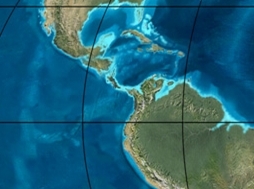 W
WThe Castillo Formation is an Early Miocene geologic formation in the Falcón Basin of Venezuela. The formation unconformably overlies the Matatere, Misoa, El Paují and Jarillal Formations. The Castillo Formation is overlain by Quaternary alluvium and in places by the Capadare Formation. The formation, deposited in a calm near-shore lagoonal brackish environment, with possibly fluvial influence, has provided a rich assemblage of fossil crocodylians, turtles, giant sloths and various types of fish.
 W
WCramauchenia is an extinct genus of litoptern South American ungulate. Cramauchenia was named by Florentino Ameghino. The name has no literal translation. Instead, it is an anagram of the name of a related genus Macrauchenia. This genus was initially discovered in the Sarmiento Formation in the Chubut Province, in Argentina, and later it was found in the Chichinales Formation in the Río Negro Province and the Cerro Bandera Formation in Neuquén, also in Argentina, in sediments assigned to the SALMA Colhuehuapian. In 1981 Soria made C. insolita a junior synonym of C. normalis. A specimen of C. normalis was described in 2010 from Cabeza Blanca in the Sarmiento Formation, in sediments assigned to the Deseadan SALMA.
 W
WCura-Mallín Group is a heterogeneous group of volcano-sedimentary formations of Oligocene-Miocene age, Colhuehuapian to Laventan in the SALMA classification, in south-central Chile and nearby parts of Argentina. The sediments belonging to the group were deposited in a lacustrine environment and alongside rivers in an intra-arc basin. Southeast of Laguna del Laja Cura-Mallín Group has a thickness of more than 1,800 metres (5,900 ft). The sediments making up the group deposited in an interval between 22 and 8 million years ago.
 W
WDiaphorocetus is an extinct genus of odontocete cetacean belonging to Physeteroidea. Its remains were found in the Monte León Formation of Argentina, dating to the Early Miocene.
 W
WDolichocebus is an extinct New World monkey genus that lived in Argentine Patagonia from about 21 to 17.5 million years ago during the Early Miocene. The type species is D. gaimanensis.
 W
WThe Eocardiidae are an extinct family of caviomorph rodents from South America. The family is probably ancestral to the living family Caviidae, which includes cavies, maras, and capybaras and their relatives. McKenna and Bell (1997) divided eocardiids into two subfamilies, Luantinae for two of the oldest genera and Eocardiinae for remaining genera. Kramarz (2006) has recommended the abandonment of these subfamilies, as the genera placed in Luantinae appear to represent basal eocardiids, rather than a specialized side branch. The latter hypothesis had been proposed by Wood and Patterson (1959).
 W
WThe Gaiman Formation, in older literature also referred to as Patagonian Marine Formation, is a fossiliferous geologic formation of the Peninsula Valdés Basin in the eastern Chubut Province of northwestern Patagonia, eastern Argentina.
 W
WIdiorophus is a genus of toothed whales in the family Physeteridae. Fossils have been found in the Colhuehuapian Gaiman Formation of Argentina and the Libano Sandstone in Italy.
 W
WNesodon is a genus of Miocene mammal belonging to the extinct order Notoungulata which inhabited southern South America during the Late Oligocene to Miocene living from 29.0—16.3 Ma and existed for approximately 12.7 million years . It had a relatively large size, weighing up to 554 kg (1221 lbs) and reaching 1.5 m in height.
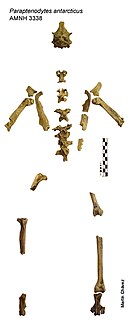 W
WParaptenodytes is an extinct genus of penguins which contains two or three species sized between a Magellanic penguin and an emperor penguin. They are known from fossil bones ranging from a partial skeleton and some additional material in the case of P. antarcticus, the type specimen for the genus, and a single humerus in the case of P. brodkorbi. The latter species is therefore often considered invalid; a recent study considers it indeed valid, but distinct enough not to belong into Paraptenodytes. The fossils were found in the Santa Cruz and Chubut Provinces of Patagonia, Argentina, in the Gaiman, Monte León and Santa Cruz Formations of Early to Middle Miocene age. Later occurrences are apparently from Late Miocene or possibly even Early Pliocene deposits.
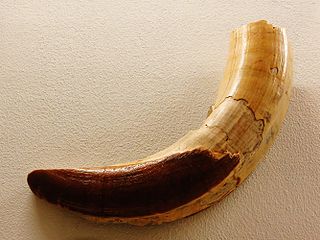 W
WParastrapotherium is an extinct genus of South American land mammal that existed from the Late Oligocene to the Early Miocene. The genus includes some of the largest and smallest known astrapotherian, but at present no generally recognized description can adequately characterize it.
 W
WPelagornis is a widespread genus of prehistoric pseudotooth birds. These were probably rather close relatives of either pelicans and storks, or of waterfowl, and are here placed in the order Odontopterygiformes to account for this uncertainty.
 W
WPeltephilus, the horned armadillo, is an extinct genus of dog-sized, armadillo xenarthran mammals which first inhabited Argentina during the Oligocene epoch, and became extinct in the Miocene epoch. Notably, the scutes on its head were so developed that they formed horns. Aside from the horned gophers of North America, it is the only known fossorial horned mammal.
 W
WPhorusrhacos is an extinct genus of giant flightless terror birds that inhabited Argentina during the Miocene epoch. Phorusrhacos was one of the dominant land predators in South America at the time it existed. It is thought to have lived in woodlands and grasslands.
 W
WProsqualodon is an extinct genus of Early to Middle Miocene cetacean from Argentina, Australia, New Zealand and Venezuela.
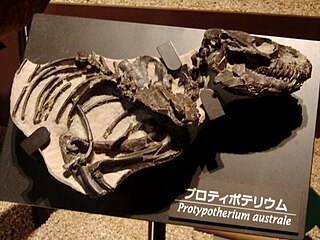 W
WProtypotherium is an extinct genus of notoungulate mammals native to South America during the Miocene epoch. A number of closely related animals date back further, to the Paleocene. Fossils of Protypotherium have been found in the Deseadan Fray Bentos Formation of Uruguay, Muyu Huasi Formation of Bolivia, Cura-Mallín and Río Frías Formations of Chile, and Santa Cruz, Salicas, Ituzaingó, Cerro Bandera, Chichinales, Sarmiento and Collón Curá Formations of Argentina.
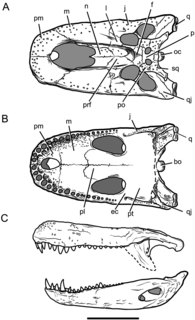 W
WPurussaurus is an extinct genus of giant caiman that lived in South America during the Miocene epoch, from the Colhuehuapian to the Montehermosan in the SALMA classification. It is known from skull material found in the Brazilian and Peruvian Amazon, Colombian Villavieja Formation, Panamanian Culebra Formation and the Urumaco and Socorro Formations of northern Venezuela.
 W
WThe family Caenolestidae contains the seven surviving species of shrew opossum: small, shrew-like marsupials that are confined to the Andes mountains of South America. The order is thought to have diverged from the ancestral marsupial line very early. They were once included in the superorder but it is now known that Ameridelphia is paraphyletic, having given rise to Australidelphia, and thus could be considered an evolutionary grade. Genetic studies indicate that they are the second most basal order of marsupials, after the didelphimorphs. As recently as 20 million years ago, at least seven genera were in South America. Today, just three genera remain. They live in inaccessible forest and grassland regions of the High Andes.
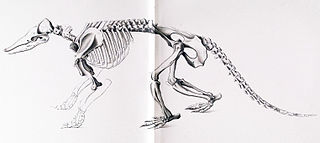 W
WStegotherium is an extinct genus of armadillo in the family Dasypodidae from Early Miocene Argentina.
 W
WTremacebus is an extinct genus of New World monkeys from the Early Miocene. The type species is T. harringtoni.
 W
WThe Uitpa Formation is a fossiliferous geological formation of the Cocinetas Basin in the northernmost department of La Guajira. The formation consists of calcareous mudstones interbedded with lithic sandstones. The Uitpa Formation dates to the Neogene period; Aquitanian to Burdigalian stages, corresponding to the Colhuehuapian in the SALMA classification, and has a maximum thickness of 230 metres (750 ft).